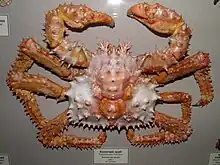Paralithodes brevipes
Paralithodes brevipes (ハナサキガニ, Hanasakigani)[2] is a species of king crab.[1] It has a limited distribution in cold, shallow waters as far south as the coast of Hokkaido,[3] where male-only fishing has damaged the reproductive success of the species,[4] up to as far north as the southwest Bering Sea.[5]
| Paralithodes brevipes | |
|---|---|
 | |
| Scientific classification | |
| Domain: | Eukaryota |
| Kingdom: | Animalia |
| Phylum: | Arthropoda |
| Class: | Malacostraca |
| Order: | Decapoda |
| Suborder: | Pleocyemata |
| Infraorder: | Anomura |
| Family: | Lithodidae |
| Genus: | Paralithodes |
| Species: | P. brevipes |
| Binomial name | |
| Paralithodes brevipes | |
They are known to be parasitized by Hematodinium.[6]
Reproductive behavior
Male P. brevipes guard females prior to copulation, spending less time doing so when females are more numerous.[7] The reproductive success of the species is heavily sensitive to the ratio of male to female crabs.[7][4] Because sperm recovery in P. brevipes occurs at a slow rate, males allocate sperm dependent on the size of the female.[8]
References
- Milne-Edwards, Henri; Lucas, Hippolyte (1841). "Description des crustacés nouveaux ou peu connus conservés dans la collection du Muséum d'Histoire Naturelle". Archives du Muséum d'Histoire Naturelle, Paris (in French). 2: 461–483. Retrieved 2 September 2023.
- Matsuno, Takao; Maoka, Takashi (1988). "The carotenoids of crab Paralithodes brevipes (Hanasakigani in Japanese)". Nippon Suisan Gakkaishi. 54 (8): 1437–42. doi:10.2331/suisan.54.1437.
- Nakanishi, Takashi (1981). "The effect of temperature on growth, survival and oxygen consumption of larvae and post-larvae of Paralithodes brevipes (Decapoda: Anomura)" (PDF). Bull. Jap. Sea Reg. Fish. Res. Lab. (32): 49–56. Archived (PDF) from the original on 11 August 2022. Retrieved 2 September 2023.
- Sato, Taku; Ashidate, Masakazu; Jinbo, Tadao; Goshima, Seiji (April 2007). "Does male-only fishing influence reproductive success of the female spiny king crab, Paralithodes brevipes?". Canadian Journal of Fisheries and Aquatic Sciences. 64 (4): 735–742. doi:10.1139/f07-044.
- Stevens 2014, p. 15–16.
- Ryazanova, T.V.; Eliseikina, M.G.; Kukhlevsky, A.D. (September 2021). "First detection of Hematodinium sp. In spiny king crab Paralithodes brevipes, and new geographic areas for the parasite in tanner crab Chionoecetes bairdi, and red king crab Paralithodes camtschaticus". Journal of Invertebrate Pathology. 184: 107651. doi:10.1016/j.jip.2021.107651.
- Wada, Satoshi; Ashidate, Masakazu; Yoshino, Kenji; Sato, Taku; Goshima, Seiji (May 2000). "Effects of Sex Ratio on Egg Extrusion Frequency and Mating Behavior of the Spiny King Crab Paralithodes brevipes (Decapoda: Lithodidae)". Journal of Crustacean Biology. 20 (3): 479–82. doi:10.1163/20021975-99990063. JSTOR 1549388.
- Sato, Taku; Ashidate, Masakazu; Jinbo, Tadao; Goshima, Seiji (24 April 2006). "Variation of sperm allocation with male size and recovery rate of sperm numbers in spiny king crab Paralithodes brevipes" (PDF). Marine Ecology Progress Series. 312: 189–99. doi:10.3354/meps312189. S2CID 84613584. Archived (PDF) from the original on 26 July 2023. Retrieved 2 September 2023.
Bibliography
- Stevens, Bradley G., ed. (2014). King Crabs of the World: Biology and Fisheries Management. CRC Press. doi:10.1201/b16664. ISBN 978-0429063176. LCCN 2013036692.
This article is issued from Wikipedia. The text is licensed under Creative Commons - Attribution - Sharealike. Additional terms may apply for the media files.